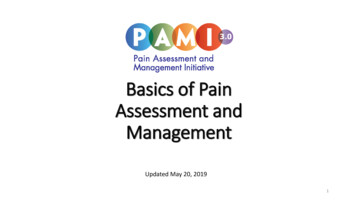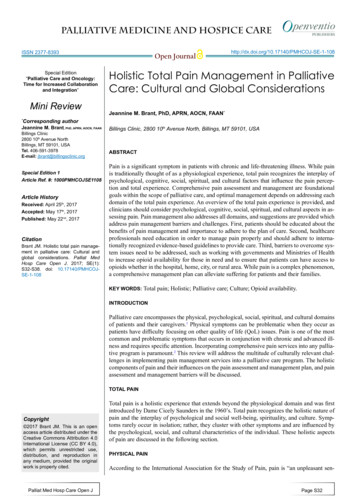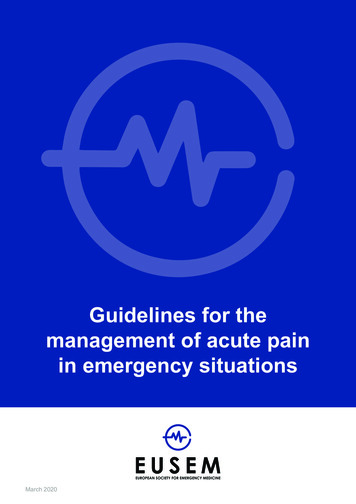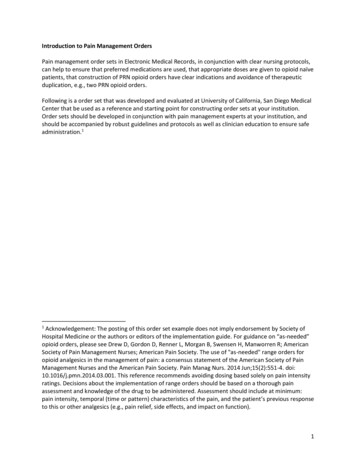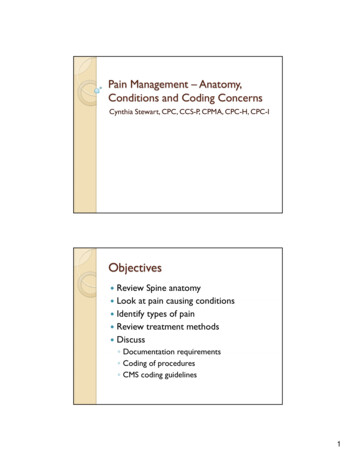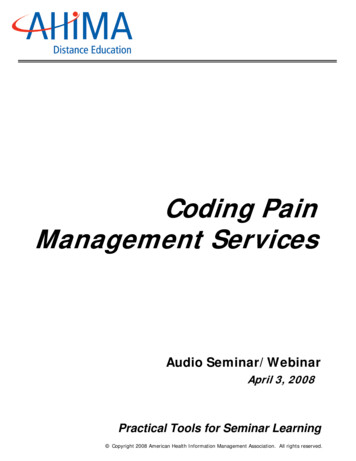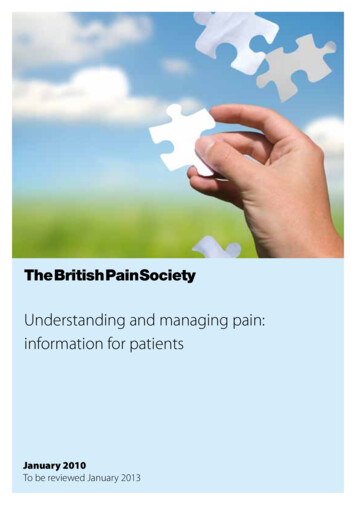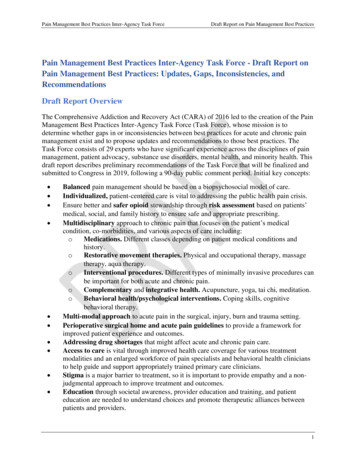
Transcription
Pain Management Best Practices Inter-Agency Task ForceDraft Report on Pain Management Best PracticesPain Management Best Practices Inter-Agency Task Force - Draft Report onPain Management Best Practices: Updates, Gaps, Inconsistencies, andRecommendationsDraft Report OverviewThe Comprehensive Addiction and Recovery Act (CARA) of 2016 led to the creation of the PainManagement Best Practices Inter-Agency Task Force (Task Force), whose mission is todetermine whether gaps in or inconsistencies between best practices for acute and chronic painmanagement exist and to propose updates and recommendations to those best practices. TheTask Force consists of 29 experts who have significant experience across the disciplines of painmanagement, patient advocacy, substance use disorders, mental health, and minority health. Thisdraft report describes preliminary recommendations of the Task Force that will be finalized andsubmitted to Congress in 2019, following a 90-day public comment period. Initial key concepts: Balanced pain management should be based on a biopsychosocial model of care.Individualized, patient-centered care is vital to addressing the public health pain crisis.Ensure better and safer opioid stewardship through risk assessment based on patients’medical, social, and family history to ensure safe and appropriate prescribing.Multidisciplinary approach to chronic pain that focuses on the patient’s medicalcondition, co-morbidities, and various aspects of care including:oMedications. Different classes depending on patient medical conditions andhistory.oRestorative movement therapies. Physical and occupational therapy, massagetherapy, aqua therapy.oInterventional procedures. Different types of minimally invasive procedures canbe important for both acute and chronic pain.oComplementary and integrative health. Acupuncture, yoga, tai chi, meditation.oBehavioral health/psychological interventions. Coping skills, cognitivebehavioral therapy.Multi-modal approach to acute pain in the surgical, injury, burn and trauma setting.Perioperative surgical home and acute pain guidelines to provide a framework forimproved patient experience and outcomes.Addressing drug shortages that might affect acute and chronic pain care.Access to care is vital through improved health care coverage for various treatmentmodalities and an enlarged workforce of pain specialists and behavioral health cliniciansto help guide and support appropriately trained primary care clinicians.Stigma is a major barrier to treatment, so it is important to provide empathy and a nonjudgmental approach to improve treatment and outcomes.Education through societal awareness, provider education and training, and patienteducation are needed to understand choices and promote therapeutic alliances betweenpatients and providers.1
Pain Management Best Practices Inter-Agency Task Force Draft Report on Pain Management Best PracticesInnovative solutions to pain management such as telemedicine, tele-mentoring, mobileapps for behavioral and psychological skills, newer medicines, and medical devicesshould be utilized as part of the overall approach to pain management.Research is required to develop a better understanding of the mechanisms of pain,preventive measures, the use of innovative medical devices and medications to preventthe acute-to-chronic pain transition, and methods to improve outcomes of chronic painconditions.Special populations are highlighted, including pediatric, women, older adults, AmericanIndians/Alaskan Natives, active duty soldiers/veterans, sickle cell disease (as an exampleof a chronic relapsing condition).Sections:1.2.3.IntroductionClinical Best Practices2.1Approaches to Pain Management2.1.1 Acute Pain2.2Medication2.2.1 Risk Assessment2.2.2 Overdose Prevention Education and Naloxone2.3Restorative Therapies2.4Interventional Procedures2.4.1 Perioperative Management of Chronic Pain Patients2.5Behavioral Health Approaches2.5.1 Access to Psychological Interventions2.5.2 Chronic Pain Patients With Mental Health and Substance UseComorbidities2.6Complementary and Integrative Health2.7Special Populations2.7.1 Unique Issues Related to Pediatric Pain Management2.7.2 Older Adults2.7.3 Unique Issues Related to Pain Management in Women2.7.4 Pregnancy2.7.5 Chronic Relapsing Pain Conditions2.7.6 Sickle Cell Disease2.7.7 Health Disparities in Racial and Ethnic Populations, Including AfricanAmericans, Latinos, American Indians, and Alaska Natives2.7.8 Military Personnel and VeteransCross-Cutting Clinical and Policy Best Practices3.1Stigma3.2Education3.2.1 Public Education2
Pain Management Best Practices Inter-Agency Task ForceDraft Report on Pain Management Best Practices3.2.2 Patient Education3.2.3 Provider Education3.3Access to Pain Care3.3.1 Medication Shortage3.3.2 Insurance Coverage for Complex Management Situations3.3.3 Workforce3.3.4 Research4.Review of the CDC GuidelineAcronymsReferences1. IntroductionThe experience of pain has been recognized as a national public health problem with profoundphysical, emotional, and societal costs.1 Today, chronic pain affects an estimated 50 million U.S.adults, and as many as 19.6 million of those adults experience high-impact chronic pain thatinterferes with daily life or work activities.2 Pain management stakeholders have been working toimprove care for those suffering from acute and chronic pain in an era challenged by the opioidcrisis.3At the same time, our nation is facing an opioid crisis that has seen an unprecedented rise ofoverdose deaths associated with prescription opioids, heroin, and synthetic opioids in the pasttwo decades.4 The practice of pain management and the opioid crisis have influenced oneanother as they each have evolved in response to different influences and pressures. It isimperative to strike a balance between ensuring that patients with painful conditions can workwith their health care providers to develop an integrative pain treatment plan that optimizesfunction, quality of life (QoL), and productivity while also ending the devastating effects ofopioid misuse.“The ongoing opioid crisis lies at the intersection of two substantial public healthchallenges — reducing the burden of suffering from pain and containing therising toll of the harms that can result from the use of opioid medications.”- Pain Management and the Opioid Epidemic:Balancing Societal and Individual Benefits and Risksof Prescription Opioid Use; National Academies ofSciences, Engineering, and Medicine, 2017.This report is the product of the Pain Management Best Practices Inter-Agency Task Force (TaskForce). The practice of pain management began to undergo significant changes in the 1990s,when pain experts recognized that inadequate assessment and treatment of pain became a publichealth issue.1 Recommendations for improving the quality of pain care5 were followed byinitiatives that recognized patients’ reported pain scores as “The 5th Vital Sign.”6 Hospitaladministrators and regulators began to focus on pain scores, encouraging and incentivizingclinicians to aggressively treat pain to lower pain scores. In addition, increasing administrativeburdens (e.g., required quality measures, electronic health records [EHRs], data management and3
Pain Management Best Practices Inter-Agency Task ForceDraft Report on Pain Management Best Practicesgovernment regulation requirements) common across all medical disciplines and settings led to alack of sufficient time for health care professionals to spend with patients to conduct assessmentof pain and determine optimal treatment plans. The administrative burden of using the EHRcontributes significantly to physician burnout, likely affecting their capacity to manage thecomplexity of pain care.7–9 As the mandate for improved pain management has increased, therewas and remains a need for greater education and greater time and resources to respond to thegreater needs of patients with painful conditions.3,10The emergence of standards recommending the improvement of pain scores, and greater use ofopioids, along with aggressive marketing of new opioid formulations, in addition to limited timeand resources, and limited coverage for non-opioid therapies, there resulted a liberalization ofopioid prescribing.3,11 Prescription opioids can be used to treat acute and chronic pain and areoften prescribed following surgery or injury as well as for a subset of patients with medicalconditions such as complex cancer or inflammatory, neurological, and musculoskeletalconditions. However, multidisciplinary, multimodal approaches to acute and chronic pain areoften not supported in time and resources, leaving clinicians with few options to treat oftenchallenging and complex underlying conditions. As medical and policymaking organizationsbegan to urge caution about the use of opioids for pain, the federal government has developed amultifaceted approach to the opioid epidemic, including the U.S. Department of Health &Human Services (HHS) 5-Point Strategy to Combat the Opioid Crisis.12 In addition, there arevarious efforts across federal, state, and local governments as well as the community, private,and academic sectors, including the Initiative to Stop Opioid Abuse and Reduce Drug Supplyand Demand issued in 2018 by President Donald J. Trump.The significant public awareness and the pressure for both federal and state regulatory agenciesand other stakeholders to address the opioid crisis has in part contributed to health care providerslimiting the number of opioid prescriptions they write. Regulatory oversight has also led to fearsof prescribing among some clinicians, with some refusing to prescribe opioids even toestablished patients on a stable opioid regimen.13 This increased vigilance and targeting of themisuse of prescription opioids and the tightening of their availability have in some situations ledto unintended consequences, such as patient abandonment and forced tapering, with establishedpatients with pain possibly transitioning to illicit drugs, including illicit fentanyl and heroin – thiswould be a separate group of patients distinguished from those with substance use disorders(evidenced by Task Force public comments). The Centers for Disease Control and Prevention(CDC) has recently noted that the opioid crisis is quickly moving to a fentanyl crisis.14 This hascoincided with an increase in the demand of the illicit drug market for synthetic opioids as wellas other substances,15,16 and with a four-fold increase in the heroin death rate since 2010.17Nationwide, nearly half of all opioid overdose deaths in 2017 involved illicitly manufacturedfentanyl. Fentanyl is an opioid used for pain and anesthesia and is 50 times more potent thanmorphine. Illicit fentanyl (manufactured abroad and distinct from medical use in the UnitedStates), with an even more potent synthetic form, has sometimes been mixed with other opioids(prescription and illicit opioids, cocaine, and other illegal substances), including heroin, resultingin sentinel outcomes because of its concentrated effect and low costs.Public comments submitted to the Task Force show growing consideration of suicide resultingfrom unrelieved pain and in some cases lack of access to treatment. According to a recent CDCreport using data from the National Violent Death Reporting System, the percentage of peoplewho died by suicide who also had evidence of chronic pain increased from 7.4% in 2003 to4
Pain Management Best Practices Inter-Agency Task ForceDraft Report on Pain Management Best Practices10.2% in 2014.18 Numbers from this data set beyond 2014 are not yet available. This findingleads to the rising concern that a recent trend of health care professionals opting out of treatingpain has contributed to an existing shortage of pain management specialists1 and is leaving somepatients without adequate access to care.Comprehensive pain management can be a challenge for various reasons. In the currentenvironment, patients with chronic pain, particularly those being treated with opioids, can bestigmatized, a tendency exacerbated when their pain condition is complicated by common mentalhealth co-morbidities such as anxiety and depression or by addiction. Opioids can have addictiveproperties in certain at-risk populations; risk assessment and periodic reevaluation andmonitoring are required for all patients in these populations and should be a part of the complexcare management they need, particularly when there is an intersection of chronic pain, opioids,mental health, and addiction. There is strong evidence that because of awareness and educationabout these issues, opioid misuse has since been decreasing, from 12.8 million individuals in2015 to 11.4 million individuals in 2017.19HHS is advancing a comprehensive overview that addresses all issues in the practice of acuteand chronic pain management, an effort that is coordinated with the 5-Point Strategy to Combatthe Opioid Crisis to recalibrate the role opioid medications play in pain care to reduce opioidharm and improve the QoL for patients living with pain.12 This work includes execution ofmandates set forth by the Comprehensive Addiction and Recovery Act (CARA), whichestablishes “an interagency task force, convened by the Department of Health and HumanServices, in conjunction with the Department of Defense (DoD), the Department of VeteransAffairs (VA), and the White House Office of National Drug Control Policy.”20 The CARAlegislation instructs the Task Force to “[d]etermine whether there are gaps in or inconsistenciesbetween best practices for pain management” and “propose updates to best practices andrecommendations on addressing gaps or inconsistencies.”20The Task Force recognizes that comprehensive pain management often requires the work ofvarious health care professionals, including physicians, dentists, nurses, pharmacists, physicaltherapists, occupational therapists, behavioral health specialists, psychologists, and integrativehealth practitioners. The complexity of some pain conditions requires multidisciplinarycoordination among health care professionals; in addition to the direct consequences of acute andchronic pain, the experience of pain can exacerbate other health issues, such as delayed recoveryfrom surgery or an activation of behavioral and emotional disorders. Achieving excellence inpatient-centered care depends on a strong patient-clinician relationship defined by mutual trustand respect and, in the case of chronic pain, empathy and compassion on the part of the healthcare provider.21 As required by congressional legislation, HHS has convened the Task Force,which consists of 29 members with expertise in pain management, patient advocacy, substanceuse disorders (SUDs), mental health, state medical boards, minority health, and veteran serviceorganizations as well as other organizational representatives. The Task Force includesrepresentatives from federal agencies, including HHS, the VA, DoD, and the Office of NationalDrug Control Policy.In 2018, the Task Force convened two public meetings that included extensive public commentand critical patient testimonials from various different patient groups. There were numeroussubcommittee meeting deliberations and discussions that included various special populationpresentations, including the Indian Health Services (IHS), the Defense Health Agency, the VA,5
Pain Management Best Practices Inter-Agency Task ForceDraft Report on Pain Management Best Practicesstate health officials, private and industry experts, and integrative pain experts. The Task Forcereviewed extensive public comments, patient testimonials, and existing best practices; consideredrelevant medical and scientific literature; and requested information from government andnongovernment experts in pain management and related disciplines. Task Force discussion andanalysis resulted in the identification of gaps, inconsistencies, updates, and recommendations foracute and chronic pain management best practices described in this report, consistent with theCARA legislation. In the context of this report, the term “gap” includes gaps across existing bestpractices, inconsistencies among existing best practices, the identification of needed updates tobest practices, or a need to reemphasize vital best practices. Gaps and recommendations in thereport span five major interdisciplinary treatment modalities: medication, restorative therapies,interventional procedures, behavioral health approaches, and complementary and integrativehealth. This report also provides gaps and recommendations for special populations confrontingunique challenges in pain management as well as gaps and recommendations for critical topicsthat are broadly relevant across treatment modalities, including stigma, education, and access tocare. The report reviews various clinical practice guidelines (CPGs), with 2018 public commentsfrom key stakeholders, patients, family members, as well as the CDC guideline.2. Clinical Best PracticesCPGs are designed to provide evidence-based information and assist in clinical decision makingto optimize patient care and outcomes. In pain management, a critical part of providingcomprehensive care is performance of a thorough initial evaluation, including assessment of boththe medical and the probable biopsychosocial factors causing or contributing to the pain, with atreatment plan to address the causes of pain and to manage pain that persists despite treatment.Quality pain management and CPGs can alter opioid prescribing both by offering alternatives toopioids and by clearly stating when they may be appropriate and how to consider risk assessmentand benefit analysis with ongoing nonopioid treatment modalities.3 Several recent CPGs forchronic pain management agree on specific recommendations for mitigating opioid-related riskthrough risk assessment, including screening for risks such as depression, active or prior historyof SUDs, family history of SUD, and childhood trauma, among other issues, prior to initiatingopioids; medication dosing thresholds; consideration of drug-drug interactions, with specificmedications and drug-disease interactions; risk assessment and mitigation (e.g., patient-providertreatment agreements); drug screening/testing; prescription drug monitoring programs; andaccess to nonpharmacologic treatments. CPGs that only promote and prioritize minimizingopioid administration run the risk of undertreating pain, especially when the cause of the pain isuncertain or cannot be reduced by nonopioid approaches.To continue improving quality of pain care in the current environment of opioid-related risks,experts have noted several key challenges associated with CPGs. First, there is the need toincrease the use of CPGs, as indicated in specific patient groups delineated by their underlyingdiagnosis or cause of pain (e.g., arthritis, postoperative, neuropathic), comorbidities,demographics, and settings (e.g., hospital, perioperative, primary care, emergency department[ED]). Second, there must be improved access to effective pain management treatments throughadoption of CPGs in medical practice and clinical health systems.22 Third, CPGs for painmanagement should be more incorporated into the routine training of clinicians,23 with specialattention to residency training to meet the needs of patients treated in each specialty.3,10 Finally,there needs to be adequate reimbursement for quality care.6
Pain Management Best Practices Inter-Agency Task ForceDraft Report on Pain Management Best PracticesPain management experts have also identified specific research gaps that are impeding theimprovement of pain management guidelines as well as other needs, including synthesizing andtailoring recommendations across guidelines, diagnoses, and populations. In addition, there aregaps and inconsistencies within and between pain management and opioid prescribingguidelines.24–26 This finding is also the result of demographic and other variances, becauseclinical best practices (CBPs) are developed in different regions and states around the country. Arecent review of clinical opioid prescribing guidelines by Barth et al.27 notes several needs —including the development of postoperative pain management guidelines for different surgicalprocedures, with the understanding of patient variability in physiology, drug metabolism andother medical underlying disease processes. This further emphasizes the need for anindividualized patient-centered approach. In light of these gaps, there are potential limitations toevidence-based clinical recommendations that should be considered by pain managementproviders.28A systematic review of CPGs for neuropathic pain29 identified shortcomings across fourevaluation domains: 1) stakeholder involvement (i.e., the extent to which the guideline wasdeveloped by the appropriate stakeholders and represents the views of its intended users); 2) therigor of development (i.e., the process used to gather and synthesize the evidence and themethods used to formulate the recommendations); 3) applicability (i.e., likely barriers andfacilitators to implementation of the guideline, strategies to improve its uptake, and resourceimplications of applying it); and 4) editorial independence (i.e., bias in the formulation of therecommendations), not to mention the knowledge and skill set of the clinician. Identifiedinconsistencies across guidelines for some painful conditions, such as fibromyalgia, havedemonstrated a need for a consensus in guideline development.30 A review of state-levelguidelines for opioid prescriptions found that a minority of states had guidelines specific toEDs.31 Pain guidelines from the World Health Organization are facing a lack of adoption,potentially because they lack incorporation of contemporary pain management practices.322.1 Approaches to Pain ManagementA multimodal approach to pain management consists of using more than one treatment modalityfrom one or more medical disciplines to be incorporated into a pain treatment plan. Suchmodalities allow for different approaches to address the pain condition (acute and chronic) froma variety of mechanisms, often allowing for a synergistic approach that addresses the differentaspects of the pain condition, including addressing improved symptoms and functionality.Multidisciplinary approaches incorporate various disciplines to address different components ofchronic, often complex pain conditions including biopsychosocial effects of the medicalcondition on the patient.33–35 The efficacy of such a coordinated, integrated approach has beendocumented in the scientific literature to reduce pain severity, improve mood and overall QoL,and increase function.34,36–41 HHS has developed a National Pain Strategy that “recommends apopulation-based, biopsychosocial approach to pain care that is grounded in scientific evidence,integrated, multimodal, and interdisciplinary, while tailored to an individual patient’s needs.”42Recent CPGs developed by the VA and DoD integrate the biopsychosocial model of pain,26 andthe Veterans Health Administration (VHA) has identified biopsychosocial care plans as anessential element to effective pain management.43 The biopsychosocial approach is appliedclinically across pain experiences, including chronic pain,44 and specifically to musculoskeletalpain,45 low-back pain,46,47 and HIV-related pain.48 Specialty interdisciplinary pain medicine team7
Pain Management Best Practices Inter-Agency Task ForceDraft Report on Pain Management Best Practicesconsultation, collaborative care, and (when indicated) mental health and addiction servicesshould be readily available in the course of treatment of pain to help ensure the best patientoutcomes.Gaps and RecommendationsGap 1: Current inconsistencies and fragmentation of pain care limit best practices and patientoutcomes. A coherent policy for pain management within health systems is needed. Recommendation 1a: Encourage coordinated and collaborative care that allows for bestpractices and improved patient outcomes whenever possible. One of many examples isthe collaborative stepped model of pain care, as adopted by the VA and DoD healthsystems.2.1.1 Acute PainAcute pain is a ubiquitous human experience49 that is classified as a physiologic response tonoxious stimuli that is sudden in onset and time limited.50 Acute pain can occur after an injury,burn, or trauma or following surgery in the perioperative period. Acute pain and chronic pain areoften interlinked, with nearly all cases of chronic pain beginning as acute pain.51 Acute painflares may recur periodically in common and complex chronic medical problems, including asexamples, but not limited to arthritis,52 neuropathies,53 spinal conditions, low-back pain,54 sicklecell disease (SCD),55 migraine,56 multiple sclerosis (MS),57 trigeminal pain or neuralgia,58 andcomplex regional pain syndrome (CRPS).59 As with acute pain flares in these and otherconditions, it is important to perform a thorough evaluation — one that leads to a presumeddiagnosis or differential diagnosis — that facilitates both diagnostic and therapeutic plans. Theoptimal management of acute pain should include establishing a diagnosis and overall treatmentplan with continuity of care.60 It is vital to consider a risk-benefit analysis with a risk assessmentapproach to provide the best possible patient-centered outcome while mitigating unnecessaryopioid exposure. To avoid the side effects associated with the prescription of opioids (e.g.,nausea, vomiting, constipation, sedation, opioid use disorder [OUD], addiction), it is important toacknowledge the benefits of multimodal, nonopioid approaches in acute pain management inconjunction with possible opioid therapy.61 Reevaluation of patient is critical in this settingbecause the use of medications to control acute pain should be for the shortest time necessarywhile also ensuring that the patient is able to mobilize and function to optimize outcomefollowing surgery or injury. Although opioids are effective in treating acute pain, patients can beat risk of becoming new chronic opioid users in the postsurgical setting. As one large studyillustrated, among a population of opioid-naive patients who were given a course of opioids totreat pain following surgery, about 6% became new chronic users. Patients who were at higherrisk for becoming chronic opioid users were patients with tobacco use, alcohol and substanceabuse disorders, anxiety, depression, other pain disorders, and comorbid conditions.62 Thisfinding further underscores the value and importance of initial clinician-patient time together aswell as appropriate follow-up time to better assess risk and provide appropriate treatment forthese complex pain conditions.Gaps and RecommendationsGap 1: Multimodal, nonopioid therapies are underutilized in the perioperative setting.8
Pain Management Best Practices Inter-Agency Task ForceDraft Report on Pain Management Best Practices Recommendation 1a: Use procedure-specific, multimodal regimens and therapies whenindicated in the perioperative period, including various nonopioid medications,ultrasound-guided nerve blocks, analgesia techniques (e.g., lidocaine and ketamineinfusions), and psychological and integrative therapies to mitigate opioid exposure. Recommendation 1b: Use multidisciplinary and multimodal approaches forperioperative pain control (e.g., joint camps, Enhanced Recovery After Surgery [ERAS],Perioperative Surgical Home [PSH]). Key components may include preoperativepsychology screening and monitoring; preoperative and postoperative consultation andplanning for managing pain of moderate to severe complexity; preventive analgesia withpreemptive analgesic nonopioid medications; and regional anesthesia techniques, such ascontinuous catheter-based local anesthetic infusion. Recommendation 1c: Develop appropriate reimbursement and authorization policies toallow for a multimodal approach to acute pain in the perioperative setting and the periinjury setting, including preoperative consultation to determine a multimodal plan for theperioperative setting.Gap 2: Guidelines for the use of multimodal clinical management of the acute pain associatedwith common categories of surgical interventions and trauma care are needed. Recommendation 2a: Develop acute pain management guidelines for common surgicalprocedures and trauma management, carefully considering how these guidelines canserve both to improve clinical outcomes and to avoid unintended negative consequences. Recommendation 2b: Emphasize the following in guidelines, which provide an initialpathway to facilitate clinical decision making:-Individualized treatment as the primary goal of acute pain management,accounting for patient variability with regard to factors such as comorbidities,severity of conditions, surgical variability, geographic considerations, andcommunity/hospital resources.-Improved pain control, faster recovery, improved rehabilitation with earliermobilization, less risk for blood clots and pulmonary embolus, and mitigation ofexcess opioid exposure.To reflect multidisciplinary approaches and the biopsychosocial model for management of acuteand chronic pain, the following sections are organized by five major approaches to painmanagement: medication, restorative therapies, interventional procedures, behavioral healthapproaches, and complementary and integrative health. The following section focuses on specialpopulations that face unique challenges in acute and chronic pain management.2.2 MedicationEffective pain management, particularly for chronic pain, is best achieved using a patientcentered, multidisciplinary, multimodal, integrated approach that may includepharmacotherapy.42,46,63 In general, two broad categories of medications are used for painmanagement: opioids and a variety of nonopioid classes of medications.64,659
Pain Management Best P
Pain Management Best Practices Inter-Agency Task Force Draft Report on Pain Management Best Practices 3 3.2.2 Patient Education 3.2.3 Provider Education 3.3 Access to Pain Care 3.3.1 Medication Shortage 3.3.2 Insurance Coverage for Complex Management Situations 3.3.3 Workforce 3.3.4 Research 4. Review of the CDC Guideline Acronyms



